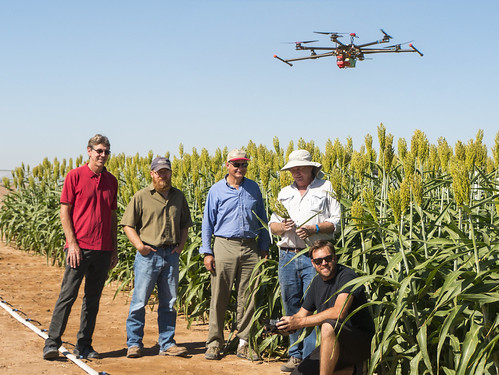
This post is part of the Science Tuesday feature series on the USDA blog. Check back each week as we showcase stories and news from USDA’s rich science and research portfolio.
Just like a smart phone helps users learn, communicate and make important decisions, smart technology—known as precision agriculture—helps farmers know and apply critical information about the right investments in fertilizer, seed, pesticide and water needed to produce their crops. Through new technologies, farmers produce more efficiently and see an increase in profits while improving stewardship of ecosystems and local communities.
To talk about precision agriculture is to talk about mapping the amount of a crop grown per acre (yield) or the types of soils in a given area. It also includes the technology that automatically guides farm machines and controls variables like the rates of seeds, fertilizers or chemicals.
Known as “VRT,” variable rate technology is one of the most important components of precision agriculture simply because fertilizer or chemicals are applied only where and in the amount they are needed. Without VRT, a farmer fertilizes at an average rate across a field, so some areas of the field get too little fertilizer reducing yield, while other parts of the field get too much fertilizer, wasting money and potentially polluting nearby waterways.
While soil and yield mapping have been a standard method for determining the amount of fertilizer needed, new sensing systems are providing an alternative and more flexible method for determining inputs. Back in the 1990’s, USDA-funded researchers at Oklahoma State University studied the problem of how to measure the amount of the common fertilizer nitrogen needed in a field.
The scientists knew that the answer depended on crop biomass – or the vegetation within the crop area-- and that could vary throughout a field. So they developed light sensors to measure certain reflections and recognize the “greenness” of the crop, indicating the amount of biomass. The resulting data was then used to calculate the amount of nitrogen needed. This success led to widely-used commercial systems and a significant reduction in over application of nitrogen that could contaminate local environments and waterways.
The Unmanned Aerial System (UAS) is one of the newest technologies being studied for improvements in agricultural precision. Though the potential value of using UAS in agriculture has received a lot of attention and systems are available at a reasonable cost, there are few examples of farmers actually using a UAS to make key decisions and take direct action. The technology can be more complicated than expected and it takes time extract usable information. Substantial research still needs to be done.
One recent project by USDA-funded researchers at the University of Minnesota is using UAS to locate pests and diseases that reduce soybean yield. Like the nitrogen fertilizer VRT, UAS could allow producers to reduce pesticide use, spraying only the areas within each field showing the disease. Because it can more quickly and thoroughly scan a field than a person can scout it, UAS could provide more timely detection with less labor costs.
In recognition of the many challenges to using UAS in agriculture, a USDA multi-state project committee recently began to coordinate this work. The project includes objectives for research and objectives for providing extension information, helping farmers evaluate the various UAS technologies and offer strategies to make it profitable.


